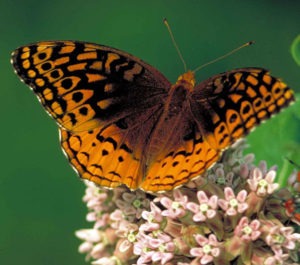
Great spangled fritillary butterflies (Speyeria cybele) are medium-sized butterflies commonly found in meadows, fields, and yards across Kentucky and many of the surrounding states. Its wingspan is approximately 2.5 to 3.5 inches wide. The name fritillary is derived from a Latin word that means checkered and refers to all the black spots on the fritillary’s wings.
Adult great spangled fritillaries can typically be observed from June until September or October. The butterflies will drink nectar from many different species including milkweeds, beebalm, ironweed, purple coneflower, joe-pye-weed, and the non-native butterfly bush. The female will lay her eggs near patches of violets. Some reports say that she can somehow sense where the violets are even if they have already wilted or dried up. Other reports say that it is more a matter of chance whether the eggs are near violets or not. When the eggs hatch, the caterpillars crawl into the leaf litter and hibernate until the next spring.
The caterpillars come out of hibernation in the spring when the violets begin to bloom. Like other caterpillars, they have voracious appetites and finding a good patch of violets is critical for their survival. Great spangled fritillary caterpillars can only eat violets, similar to how monarch caterpillars can only eat milkweeds. The caterpillars will molt several times as they grow. Eventually they will create a black chrysalis in which to metamorph into an adult butterfly and begin the cycle again. So before pulling up all those violets taking over your garden or yard, you might want to consider leaving some as food for the caterpillars of this beautiful Kentucky pollinator.

This article was part of Shannon’s original Kentucky Pollinators and Backyard Wildlife blog which evolved into the blog for Backyard Ecology.

Backyard Ecology: Exploring Nature in Your Backyard
Nature isn’t just “out there.” It’s all around us, including right outside our doors. Hi, my name is Shannon Trimboli, and I am the host of Backyard Ecology. I live in southcentral Kentucky and am a wildlife biologist, educator, author, beekeeper, and owner of a nursery specializing in plants for pollinators and wildlife conservation. I invite you to join me as we ignite our curiosity and natural wonder, explore our yards and communities, and improve our local pollinator and wildlife habitat. Learn more or subscribe to my email list at www.backyardecology.net.

Leave a Reply